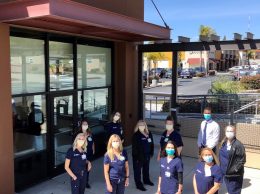A strong El Niño is likely to happen for the first time since 1998, and it’s whipping up hysteria throughout California. Central Coast farmers have reason to be skeptical, though, that the rains will actually come.
Meteorologists say that a strong El Niño does not mean there will be more rain on the Central Coast, but it does make it more likely. Farmers are hopeful that light rains will fall for several days.
El Niños do not cause rain. An El Niño is simply a warming of the ocean, said Robert Munroe, meteorologist at the National Oceanic and Atmospheric Administration in Oxnard.
He said a weak or moderate El Niño does not mean there will be more rain. Only strong El Niños bring lots of rain and Munroe said this year’s El Niño might be strong.
Munroe defined a strong El Niño as conditions where average sea surface temperatures increase by more than 1.5 degrees Celsius for about three months.
“The warming of the Central and East Pacific adds additional energy to the subtropical jetstream,” Munroe said. “That creates more frequent and stronger systems in our part of the world.”
Ikeda Brothers is a family-owned farm in south San Luis Obispo County that produces cabbage, bok choy, celery, lettuce bell peppers and other produce.
Tom Ikeda, a third-generation farmer, said producers have to be prepared for heavy rains this winter but they are doubtful that the rain will come.
“In general we’re skeptical but we have to be somewhat prudent and be somewhat prepared,” Ikeda said. “The general feeling is, ‘I’ll believe it when I see it.’”
Some farmers in the area use more blunt language to describe their current predicament, which is ongoing drought, said Ron Loop, communications manager for the California Association of Winegrape Growers.
“One of our growers said if (rain) doesn’t happen it’s going to be ‘El Screw-o’,” Loop said.
Ikeda and other growers have reason to be skeptical. According to the state Department of Water Resources, only five strong El Niños have happened since 1950: 1958, 1973, 1983, 1992 and 1997-98.
This winter’s possible El Niño has drawn comparisons to the last strong El Niño in California.
In 1997, strong rains from April through August caused $1.1 billion in economic damage to California’s economy because of severe flooding and landslides. In February of 1998, weeks of rain brought water to California, but also caused an additional $550 million in damages to the state’s economy.
One epic storm driven by the El Niño even dropped 13 inches of rain on Santa Barbara County in one day in February of 1998.
“A strong El Niño would increase our possibility of having enough precipitation in a short period of time to cause mudslides,” Munroe said.
So not all rain is good.
“If we get a great big dumping all at once, that’s not going to be as helpful as when we get shorter episodes spread out over time,” said California Strawberry Commission Communications Director Carolyn O’Donnell. “I don’t know that I could quantify that, but if we get rain that causes fields to flood, that’s not good.”
Surrendra Dara, strawberry and vegetable crop advisor at the University of California Extension, said strawberries are planted early in the winter. Dara said young berries might be able to survive torrential downpours or even flooded fields. Rains later in the season hurt mature berries more.
Loop said if rain continues into the early spring planting season, it could interfere with how grapes grow on the vine.
“Rain would interfere with clusters on the vine so you would get berries that aren’t uniform in size,” Loop said.
Even if an El Niño doesn’t bring the Armageddon-like rains the Tri-Counties saw in 1997 and 1998, if an El Niño makes the area more humid it could spur diseases that could hurt crops.
“Not only the rain, but the dampness,” Dara said. “If there’s too much moisture for too long, things … will rot in water, that kind of thing.”
Rain alone won’t save California farms. The state needs heavy snow.
“It’s not just rain that our growers are concerned about. It’s the snowpack in the Sierra (mountains),” Loop said. “The groundwater is the savings account. The snowpack is the checking account.”
Four years of crippling drought has endangered the livelihoods of 77,900 farmers in California.
So pray for rain, but be careful what you wish for.






 Print
Print Email
Email

















